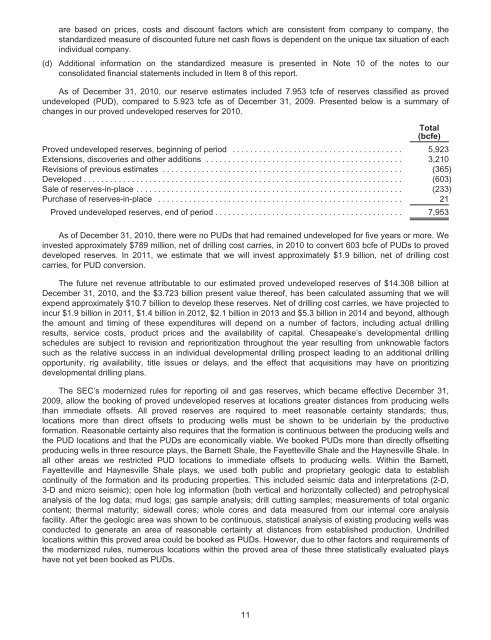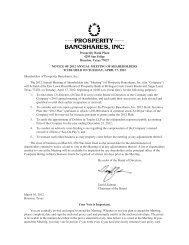6 5 - RR DONNELLEY FINANCIAL - External Home Login
6 5 - RR DONNELLEY FINANCIAL - External Home Login
6 5 - RR DONNELLEY FINANCIAL - External Home Login
You also want an ePaper? Increase the reach of your titles
YUMPU automatically turns print PDFs into web optimized ePapers that Google loves.
are based on prices, costs and discount factors which are consistent from company to company, the<br />
standardized measure of discounted future net cash flows is dependent on the unique tax situation of each<br />
individual company.<br />
(d) Additional information on the standardized measure is presented in Note 10 of the notes to our<br />
consolidated financial statements included in Item 8 of this report.<br />
As of December 31, 2010, our reserve estimates included 7.953 tcfe of reserves classified as proved<br />
undeveloped (PUD), compared to 5.923 tcfe as of December 31, 2009. Presented below is a summary of<br />
changes in our proved undeveloped reserves for 2010.<br />
Proved undeveloped reserves, beginning of period .......................................<br />
Total<br />
(bcfe)<br />
5,923<br />
Extensions, discoveries and other additions ............................................. 3,210<br />
Revisions of previous estimates ....................................................... (365)<br />
Developed ......................................................................... (603)<br />
Sale of reserves-in-place ............................................................. (233)<br />
Purchase of reserves-in-place ........................................................ 21<br />
Proved undeveloped reserves, end of period ........................................... 7,953<br />
As of December 31, 2010, there were no PUDs that had remained undeveloped for five years or more. We<br />
invested approximately $789 million, net of drilling cost carries, in 2010 to convert 603 bcfe of PUDs to proved<br />
developed reserves. In 2011, we estimate that we will invest approximately $1.9 billion, net of drilling cost<br />
carries, for PUD conversion.<br />
The future net revenue attributable to our estimated proved undeveloped reserves of $14.308 billion at<br />
December 31, 2010, and the $3.723 billion present value thereof, has been calculated assuming that we will<br />
expend approximately $10.7 billion to develop these reserves. Net of drilling cost carries, we have projected to<br />
incur $1.9 billion in 2011, $1.4 billion in 2012, $2.1 billion in 2013 and $5.3 billion in 2014 and beyond, although<br />
the amount and timing of these expenditures will depend on a number of factors, including actual drilling<br />
results, service costs, product prices and the availability of capital. Chesapeake’s developmental drilling<br />
schedules are subject to revision and reprioritization throughout the year resulting from unknowable factors<br />
such as the relative success in an individual developmental drilling prospect leading to an additional drilling<br />
opportunity, rig availability, title issues or delays, and the effect that acquisitions may have on prioritizing<br />
developmental drilling plans.<br />
The SEC’s modernized rules for reporting oil and gas reserves, which became effective December 31,<br />
2009, allow the booking of proved undeveloped reserves at locations greater distances from producing wells<br />
than immediate offsets. All proved reserves are required to meet reasonable certainty standards; thus,<br />
locations more than direct offsets to producing wells must be shown to be underlain by the productive<br />
formation. Reasonable certainty also requires that the formation is continuous between the producing wells and<br />
the PUD locations and that the PUDs are economically viable. We booked PUDs more than directly offsetting<br />
producing wells in three resource plays, the Barnett Shale, the Fayetteville Shale and the Haynesville Shale. In<br />
all other areas we restricted PUD locations to immediate offsets to producing wells. Within the Barnett,<br />
Fayetteville and Haynesville Shale plays, we used both public and proprietary geologic data to establish<br />
continuity of the formation and its producing properties. This included seismic data and interpretations (2-D,<br />
3-D and micro seismic); open hole log information (both vertical and horizontally collected) and petrophysical<br />
analysis of the log data; mud logs; gas sample analysis; drill cutting samples; measurements of total organic<br />
content; thermal maturity; sidewall cores; whole cores and data measured from our internal core analysis<br />
facility. After the geologic area was shown to be continuous, statistical analysis of existing producing wells was<br />
conducted to generate an area of reasonable certainty at distances from established production. Undrilled<br />
locations within this proved area could be booked as PUDs. However, due to other factors and requirements of<br />
the modernized rules, numerous locations within the proved area of these three statistically evaluated plays<br />
have not yet been booked as PUDs.<br />
11











